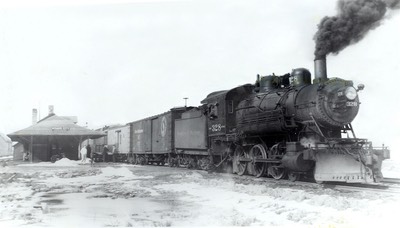Vilhelm Moberg
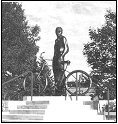
Why a statue of Moberg? He wrote about emigrant Swedes who comprised the largest ethnic population that settled Chisago City in 1855. He did it with a series of books that speak to a time when more than Swedes were coming to America. Moberg described the pain of forsaking one's homeland and going to a fate uncertain, leaving starvation and even greater uncertainty for the hope of a new and better life.
Moberg is one of the best-known Swedish authors (he has been published in over 20 languages). He wrote of the early lives of the Swedish settlers and their journey to the land of Ki-Chi-Saga – Chisago Lakes. Families in Sweden were ripped apart by emigration, leaving few members to survive as best they could. Mothers and Fathers actually paid their children not to leave their homes and families. But many did leave, and arrived in a land very similar to the one they had left - however, it was a land filled with hope. Moberg is more popular today than probably ever before. His works speak to people of hardships, love, politics, royalty, and society. His masterwork was “The Emigrant Tetralogy,” published between 1949 and 1959.
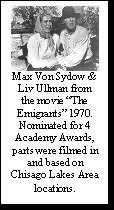
During the summer of 1948, Moberg stayed in Chisago City and bicycled around the Chisago Lakes area. He visited many places and talked to many people. From this research he got a feel for the area, gathered information and collected stories that formed background for his most famous works. He was not the only person who used the Chisago Lakes Area for research. Before Nils Hasselmo became the president of the University of Minnesota he also studied the area's language. While Swedish was still spoken here, the nature of the usage was frozen to the time when the speakers had immigrated creating a sort of time capsule of the language.
Moberg was a common man, wrote about common people living in difficult times. In many ways, although the experience he knew best was from the Swedish point of view, this was a story told countless times by countless nationalities – a story that is being told to this day.
In 1996, the year of the 150th Swedish Immigration Jubilee, on March 19 local sculptor Ian Dudley was commissioned to create a statue of Moberg for central park in Chisago City. The casting was done by American Bronze Casting in Osceola, Wisconsin between June and July of 1996. The statue is comprised of 12 separate pieces of cast bronze. Weighing over 800 pounds, (each wheel alone is 80 lbs.!) it stands 93” tall and is 81” wide. The statue arrived in Chisago City on August 7th and was set on its foundation.

On September 7, 1996, a dedication was held and two of Vilhelm Moberg’s daughters, Brigitta Räd and Marianna Forssell, were present as part of the summer long Swedish Immigration Jubilee that was hosted in the Chisago Lakes area. It was dedicated to the memory of the over 1.2 million Swedes who had immigrated to the United States. The ceremony included Gustavus Adolphus professors Roger McKnight and Roland Thorstensson (Board member of The Moberg Society) along with music provided by local musicians and the Swedish Institute. The celebration and dedication were broadcast live over radio.
The following week, on September 13th, the City was proud and honored to welcome their Royal Majesties King Carl XVI Gustav and Queen Silvia of Sweden along with Governor Arne Carlson with an original fanfare written and performed by William Butler. While in Chisago City they viewed the statue and dedicated the park as Vilhelm Moberg Park before continuing their tour of the area.
For the dediction of the statue, the King & Queen's visit and 2 years later for a centennial celebration of Vilhelm Moberg's birthday there were special first day stamp cancellations.
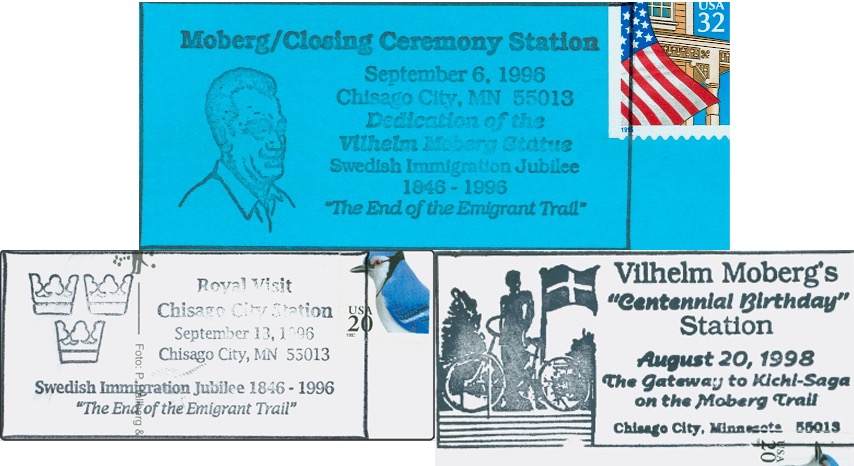
The Chisago Lakes Area is probably best known in Sweden and over 20 other countries thanks to the Emigrant Saga of Vilhelm Moberg.
Chisago City also formed a Sister City (Sally Barott and Barbara Young discuss Sister City signs in Chisago County Historical Society's "Heriage" November 2009 newsletter article(provided with the permission of the Chisago County Historical Socity)) relationship with Algutsboda Sweden during the summer of the Jubilee.
The Railroad

On August 21,1880 the St. Paul & Duluth railroad company celebrated the completion of the first 11 miles of the Taylors Falls & Lake Superior branch line to Center City by taking a delegation of St. Paul resindents on an outing to see the countryside. The 8/23/1880 edition of the St. Paul Daily Globe carried a colorful report of the adventure. By December the branch line was extended to Taylors Falls. This signaled great changes for Chisago City. It struck a deathblow to the original center of town – now called Old Towne – which was not located near the tracks. The line ran north of the lakes along the most direct and inexpensive route. It bypassed the original City by about a mile, meaning that businessmen like Otto Wallmark (general store goods) would find it in their and their customer’s best interests to be closer to the railroad line. The depot sat on the SW corner of what is now Old Towne Road and Highway 8 (now Vilhelm Moberg Park ).

This vital link connecting Chisago City with the rest of the state and county provided regular mail service and transportation for people and goods. The city exported potatoes, which were stored in warehouses (at one time there were 5) along the railroad line and butter from the creamery, shipped by the carload to eastern markets.
The railroad also helped the popular and prosperous tourist industry. Vacationers from the Twin Cities would jump off the train on Friday night, go to their favorite hotel and resort (Dahl House, Russel Beach, Schlemmer's Island Hotel, Squirrel Beach and others), and on Sunday night they would carry gunnysacks of fish back on the train for the trip home.
The importance of the railroad to Chisago City would eventually diminish as cars and trucks became more popular. Businesses started to locate along highway 8 (constructed in 1924) as it wandered through the city, as well as along the railroad line. No one having what could be termed a “heavy industry” (such as grain, lumber or iron) along the line would spell the end for the railroad when it made its last run with engine 328 on July 1, 1948. A loving tribute to this last run was the first chapter (Last Run of Trains #725/726) written as part of Richard Thompson & Steven Monson's book "The Taylors Falls & Lake Superior Railroad." (Mr. Thompson is also the owner/operater of the Ironhorse Central Railroad Museum where he provides rides on several operational locomotives and cars over a circular track on his property). The train had always carried more passengers than freight and with the increasing popularity of the automobile and the statewide push to pave major roads, such as highway 8, the automobile became the preferred method of travel.This closed an era of excitement for the area, and also marked the start of a transition from resorts to permanent lake homes.
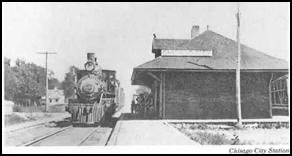
When highway 8 was straightened through Chisago City and rebuilt in 1950, it was constructed on the bed of the old railroad line. This meant that, once again, the businesses would have to readjust to a new town focus (where it actually was back in 1880 when the railroad was built!)
The Telephone
The telephone came to Chisago City in 1909. Persons interested in organizing a telephone service met in March of 1909 and named C.E. Swenson, C.W. Dixen, George Noren, Albert Peterson, and Lot Linn as the first Board of Directors, and incorporated the Chisago City Cooperative Telephone Company.
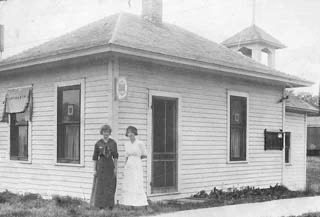
The company’s rates reflected its cooperative nature. Stockholders living within a quarter of a mile of the line were to contribute two days work in constructing the line. Those living further away had to furnish and set poles for the lines to their own residences. In April, the Directors ordered poles and contracted for service with Wyoming and Lindstrom. By May of 1909, an office in the Bloom Mercantile was rented and the rates were set: stockholders paid $0.75 per month for a residential phone and $1.50 per month for a business phone. All non-stockholders were assessed an additional $0.25 per month. Delinquent bills were charged an extra $0.25 and night calls, which required the waking of the operator, were $0.10 more between 10:00 p.m. and 6:00 a.m.
View looking east on Railroad Ave. toward Old Towne Road
(left to right) Fire bell tower –telephone bldg.–Glyer bldg –Bloom bldg. (after fire of 1911)– first drug store
In its first year, the Chisago City Telephone Company showed a sale of $2,225 in stock, and earnings of $265.19. The central office sat on the NW corner of Railroad and Old Towne Road. The first operators were Alida Brandt and Arlene Bloom, who earned $25.00 and $18.00 per month, respectively. Josie Brandt and Minnie Gustafson were hired as assistant operators. Albert Peterson, the lineman, who furnished his own transportation, earned $65.00 a month. By 1919, the phone company was paying a 6% dividend on its stock; three years later, it was up to 12%.
Some of the original organizers and directors served for many years. C.E. Swenson was chairman for the first thirty years. George Noren (1876-1982), who was on the original Board of Directors, succeeded Swenson as chairman, and held that office until his retirement. Julius E. Vanstrom was secretary from 1909 to 1931 and from 1942 to 1955.
Chisago City Post Office
The first post office in the Chisago Lakes Area was established in the Old Towne neighborhood of Chisago City on November 3, 1856, with Henry S. Clinger, a merchant, serving as postmaster. This was not unusual because proprietors of general merchandise stores typically looked after the postal service in small communities.
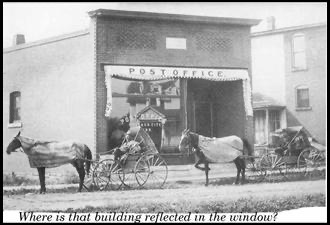
Bernheimer’s general store in Old Towne housed the post office for some time. Otto Wallmark, who was also a clerk at Bernheimer’s store and taught school, later bought the store with Henry Clinger. The activity in Chisago City can be gauged by the number of people who picked up their mail at the post office. By 1860, 17 farmers were picking up their mail, and by 1870, it had increased to 40. Daniel S. Arnquist, Wallmark’s son-in-law, served as the City’s second postmaster from 1877 until 1894.
In 1895, the post office was moved to the J.A. Bloom and Brother General Merchandise store in the Village of Chisago. J. August Bloom later built a separate post office, on Old Towne Road to the south of his store and across from the Triangle Park – behind Bloom’s store before 1911 fire), and was the third postmaster, serving from 1894 into the late 1930’s.
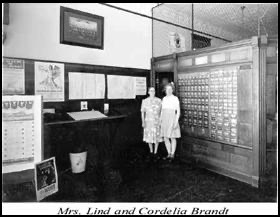
The building was damaged and for a time moved back to the West half of what is now the drug store. The building was later used for several things including an arcade and an antique store. In 1966, the post office moved into a new building where it is located today. It was around this time that the old Post Office Building was torn down, to make way for a parking lot.
Chisago City Schools
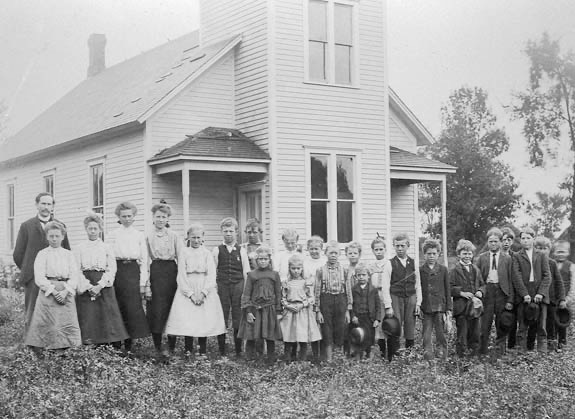
In 1857, the District 8 (East) school was established in Old Towne (a plaque notes this site which is across from the Margaret S. Parmly Nursing Home and Vindauga View assisted living on the southeast corner of the primary school playground). As more people settled in the area, more schools were built so children didn’t have to go such great distances to school.
By the late 1870s the bridge that allowed easy access to Chisago City "Old Towne" had 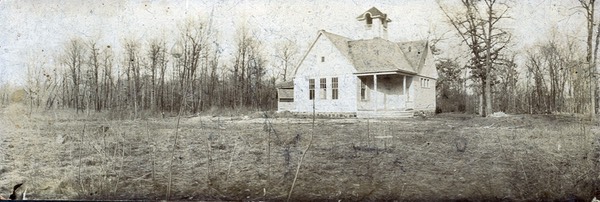 fallen into disrepair. With the coming of the railroad in 1880 there was no longer the money or the need to provide that easy access. However it did cause a problem for children going to school. The solution was to establish a new school on the east side of the lake. That school was known officially as District 8 West, but was more commonly known after the neighborhood in which it resided - Bonnie Glen.
fallen into disrepair. With the coming of the railroad in 1880 there was no longer the money or the need to provide that easy access. However it did cause a problem for children going to school. The solution was to establish a new school on the east side of the lake. That school was known officially as District 8 West, but was more commonly known after the neighborhood in which it resided - Bonnie Glen.

The original Old Towne school building was moved North about a mile to the NW corner of Stinson Avenue and Old Towne Road in 1900. As the school’s population grew, a larger school was built behind the old one. The old school building was sold to C.A. Palmer, who moved and remodeled the structure for a home. That house stands today on the SE corner of Old Towne Road and Lake Avenue.
 The larger and newer school was eventually used by Zion Lutheran Church for religious education and services (from approximately 1920 until?). The building was also used by the Chisago Lakes Baptist Church (until about 1973) and as Chisago City Hall (until 1995). After 1995, the cost of bringing the old school building up to code (for continued use as a public building) was more than the city wanted to spend. The city offices moved to the newly built Municipal Building and the old school was torn down. There are now twin homes on this site.
The larger and newer school was eventually used by Zion Lutheran Church for religious education and services (from approximately 1920 until?). The building was also used by the Chisago Lakes Baptist Church (until about 1973) and as Chisago City Hall (until 1995). After 1995, the cost of bringing the old school building up to code (for continued use as a public building) was more than the city wanted to spend. The city offices moved to the newly built Municipal Building and the old school was torn down. There are now twin homes on this site.

As transportation improved and the population grew, changes were made in how education was provided. The districts #34 (Oak Terrace (Stohl)), #38 (Lindboom), #40 (Green Lake), #8 West (Bonnie Glen), as well as the original Chisago City school District 8 (then called #8 East) were consolidated into a larger and more efficient building - District #136 (Lakeside.)
The first Chisago City school that had 12 separate grades was built in 1920 on the shore of Little Green Lake on the west side of the City. The Lakeside school was not named for its location; it was named after the local baseball team according to Elvice Bloom (daughter of J. A. Bloom) who was there at the time.
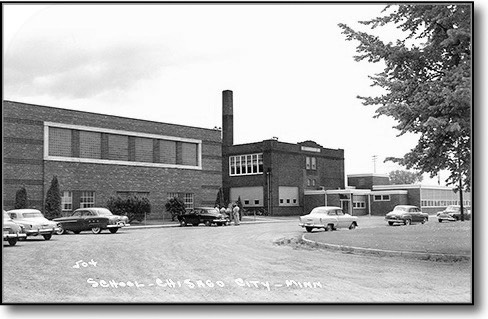
In 1939 the district added on a new auditorium and gymnasium.
An addition of additional classrooms sometime before the 1959 addition.
In 1959 another addition was made including a kitchen, cafeteria, band room, science lab, nurses office, shop, the District office, and home economics room.
Chisago City continued to grow and even more space was required. In 196x a separate Elementary School was built back on the southern side of the city on Old Towne Road to house grades xx to xx. The school and ballfield sits on property where the original Chisago City District 8 school sat. On the corner of 282nd St. and Old Towne Road behind the backstop there is plaque marking the location of the Chisago's first school.
In 1985, the part of the school that was the original 1918 structure was replaced with a larger building with modern classrooms (and it was dedicated in 1986). This school has been added onto over the years and stands today although Chisago City is now part of consolidated district #2144 that includes Lindstrom, Center City, Shafer and Taylors Falls.
In 2019, Chisago City’s Lakeside Elementary will be replaced by a new building.

.
Clock and Carillon
The dedication that occurred during Ki-Chi-Saga Days 2001 showed off a new addition to Chisago City – a town clock with carillon.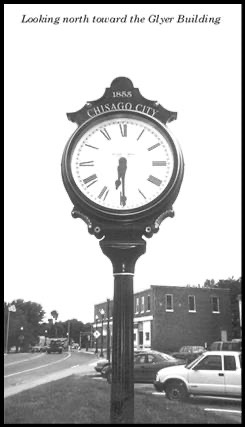
The family of Barton V. Lundquist (b 8/6/11 - d 8/6/99) donated the clock in his memory. They also donated the carillon that marks the hours and rings out songs at 12 noon, 3 and 5 PM daily. Barton and his family are lifelong residents of Chisago City, owning and operating several businesses. Barton’s father Karl Lundquist was Chisago City’s first druggist.
The land the clock sits on is commonly referred to as Triangle Park. While J. Earnest Johnson, a local businessman, donated the parkland to the City in 1966, it had long been used as an open space for public purposes.Triangle Park was the center of Chisago City between the construction of Highway 8 in 1924 and the relocation of the highway in the 1950’s (where it is today).
A large evergreen tree used to dominate this small plot of land, and Triangle Park served as the Christmas tree and holiday lighting center in the old days. You can almost see the cars driving through the city on narrow streets, ghosts of the past, the people gathering here to sing carols as the tree was lit marking the arrival of another Christmas.
One can sit here and still see much of the activity in the City. There are dreams in the City that someday this area can again form a focus of energy for the future. With that in mind when locations for the clock were discussed, Triangle Park was a logical and sentimental choice. It will bridge the old with the new, commemorating the founding of the City’s “Old Towne” in 1855, while looking toward the future (as it is located in the “New Town” the city moved to when times changed.) But whether old or new it is still Chisago City.
